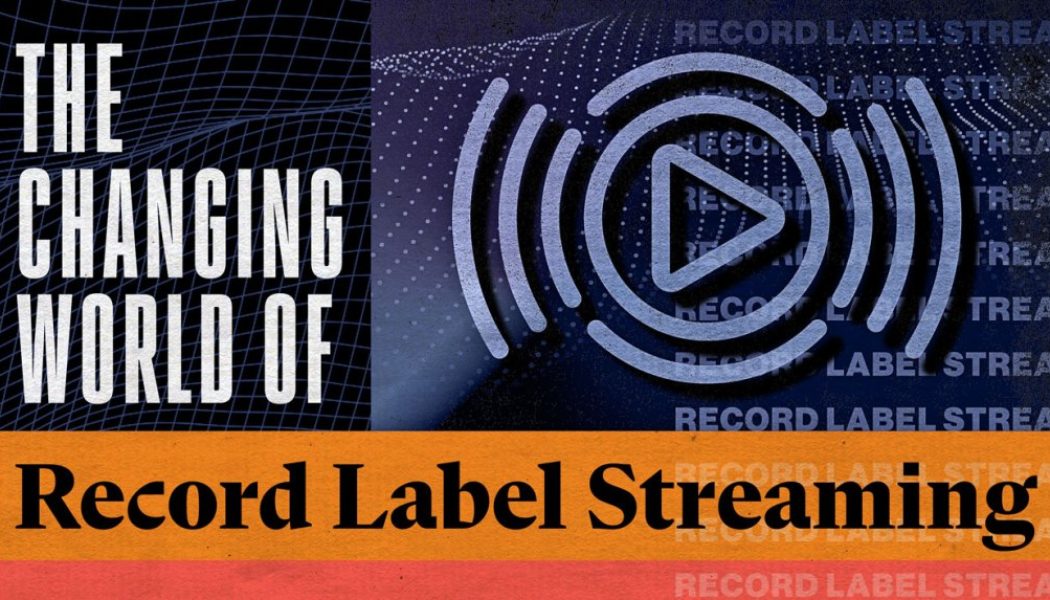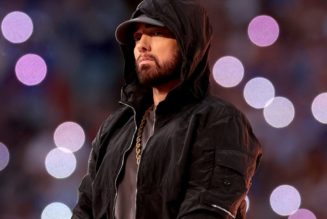
In 1999, Pavement put out the single “Spit On a Stranger,” pairing it with the B-side track “Harness Your Hopes” as a CD-only release. A decade later, in 2008, the band’s 1997 album Brighten The Corners was released in expanded form to digital retailers like Apple’s iTunes Store, complete with bonus tracks and B-Sides from those sessions, including “Harness Your Hopes,” which appeared digitally for the first time. And that’s where the journey for many of those songs would have ended: as footnotes and rarities for collectors and superfans.
But the rise of streaming and social media changed all that. In 2017, for reasons that are still a little mysterious to both the band and its label Matador, “Harness Your Hopes” began to explode on Spotify, leaping into the top spot among Pavement’s most-streamed songs. (Today, it has 74 million streams on the platform — well more than double the band’s No. 2 track, the commercially-successful “Cut Your Hair,” which has 31 million.) Three years later, during the COVID-19 pandemic, “Harness Your Hopes” spiked again, this time on TikTok. But this time, the label was ready.
“We were coming around the bend to the anniversary of this record Terror Twilight” — the 1999 album on which “Spit On a Stranger” is found, for which “Harness Your Hopes” was the B-side — “and we were like, ‘We should find a way to lean into this and have that track have its moment on the service,’” says Brandon Becker, global head of streaming at Matador’s parent company Beggars Group. The band released a new music video for the two-decade-old track on YouTube in March, then teamed up with Spotify for an exclusive, 500-copy vinyl release of the Spit On a Stranger EP — which initially retailed for under $20, and is now all over eBay for more than $100 — in April, complete with a new live version of “Harness Your Hopes” from the band’s iconic 1999 concert in Brixton, ahead of a 30-year reunion tour for the group set to kick off this summer.
The song’s belated journey to well-known status, and the band’s and label’s embrace of the streaming partners that helped it along, is emblematic of the changing relationship between record labels and the streaming services on which they’ve come to rely, where one of the keys, particularly for an indie artist, is in “finding moments like that to really amplify and connect with listeners that feels organic and not so forced,” Becker says. “You’ll also see, on the other side of the coin, a lot of the bigger pop artists are really hammering you with different versions of tracks, remixes — it never ends for a new release strategy. Any re-work of a track where you can trigger that algorithm to push it into Discover Weekly or Release Radar is going to be an important part of a campaign to keep that momentum going.”
Over the past decade, as Spotify and its streaming competitors like YouTube, Apple Music, Amazon Music and more helped usher in one of the biggest format shifts the music business has ever seen, the recorded music business has changed dramatically in response, from treating streamers as just another partner amid a suite of digital services to watching streaming account for 83% of all recorded-music revenues in 2021 in the United States, according to the RIAA. But they have not changed in a vacuum: within that decade, the services themselves have evolved, consumer behavior has radically transformed and the way artists and labels release music, and at what speed and in what packaging, has continued to vary in ways both big and small.
“The big thing with streaming — and something that I think people are still trying to understand — is the marketplace originally was set up to sell a product,” says Max Kaplan, vp of digital sales at Columbia Records. “But if you need to trigger actions multiple times over a long period of time, in order to promote an artist and in order to get paid, you need to think about how you disperse that content. You’re competing for time and not money. So the framework has really shifted from that perspective.”
As part of a continuing series looking at how the record labels are changing, Billboard spoke to six people from six different labels about how their approach, and job, within the streaming world has evolved over the past several years, and how it may continue to change in the future. (Check out previous installments on A&R, radio promotion and marketing.) But even in spite of constant flux, some elements will always remain.
“My job has always essentially been pitching songs to gatekeepers, which were the next step directly to consumers,” says Adam Abramson, Elektra’s head of sales and streaming. “In the olden days, that was lobbying for listening posts and end caps and sale pricing and positioning and all that. But philosophically, it’s the same thing now: I’m still lobbying, now for playlisting and banners and digital on- and off-platform visibility, using a lot of the same tools, just in a different marketplace.”
The Job
There are many paths into the streaming space at a label: through the sales department, which originally picked up the DSP partners in the early days; through the revenue or finance departments, which have been heavily involved in trying to maximize that revenue from streaming and shifting strategies to do so; or through digital marketing, which has in many ways grown up and matured alongside the streaming evolution.
Initially, however, the job grew out of the transition from physical to digital sales, and positioning releases in digital outlets rather than physical retailers. “If you didn’t have real estate on the front page of iTunes, your release may as well have never even come out,” explains Kaplan of the time when Apple’s iTunes Store dominated the digital download realm. So when streaming came along, “The job was similar: you’re working in partnership with the available DSPs to highlight your content, to do creative marketing campaigns together,” he continues. “It still is somewhat a little bit of the Wild West, although I think a lot of it now has been settled, but back then I think everyone was still trying to figure it out. There were a lot of gaps in what was available on platform.”
Those gaps — due to legacy-act catalog holdouts, or windowed or exclusive releases, or even artists, like Adele, who initially refused to put their albums on streaming services at all — were happening as the industry was beginning to shift towards streaming as a workable model, but before it had truly become the revenue behemoth it has become today.
“We were just trying to think of how to bring that physical medium to a digital platform, and I think Spotify was pretty focused on that at that point as well, and then maybe 18 months or two years in they started pivoting to their own editorial, which was the rise of New Music Friday and a lot of the big Today’s Top Hits and tastemaker properties that are what they are now,” says Becker, who worked at Sony’s catalog division Legacy Recordings for those earlier years “Our mindset now has diversified. Not only are we focused on the editorial piece of the conversation, but we’re also talking about audience development and fan engagement as we would a social platform. Our goal at the end of the day is to reach the widest net of potential listeners as possible for a release, and then carry that torch beyond that moment.”
Of course, those goals aren’t achieved overnight: one of the most important roles for label execs in the streaming space is about relationships, not dissimilar to how promoters cultivate relationships with radio programmers to help get songs played.
“It’s about maintaining relationships and making them feel like they’re a part of the project from the beginning, getting people music early, making contact with the artists if they’re in the same market, getting them out to shows, and really making them feel that they’re part of our family because ultimately we’re all partners in this together,” says Abramson. “So it’s really trying to make sure everyone knows what’s going on with our releases, why they’re important, why they’re relevant, to whom they’re relevant, who our audience is and who we’re trying to reach, and at the end of the day hoping that that’s gonna turn into editorial playlisting, social media, marketing activations, all of those things.”
“What shows up every Thursday night or Friday morning is certainly not accidental,” adds Nicole Csabai, vp of revenue at Interscope. “That’s weeks and weeks of work to plot out as much as we can. Always certain things are discretionary with the DSP and up to their editorial voice, but there are a lot of things on there that we are actively working towards landing for our artists.”
These days, that’s done with data — both data gleaned from specific DSPs, but also social media sites as well as the traditional ticket sales, radio spins and marketing and promotion buzz that has always been part of the story. “Streaming has given us the opportunity to craft more exact strategies, to understand the behavior of the consumer, know what song is working in an album and is having more acceptance,” says Raymond Acosta, head label manager at Rimas, the label behind streaming sensation Bad Bunny. “We can also see what the listener is looking for and we can map the growth of the song or album in real time and react directly to the consumer. The way data is measured now, and the fact that charts are updated daily, allows my role to be more analytical and lets me make better decisions.”
More specifically, “I spend a good chunk of time digging into skip rates, save rates and other engagement metrics on the various services and then finding ways to tell that story back to the platforms,” says Becker. “There’s a lot of ways that you can look at the numbers, but the thing that we look at first and foremost is trying to find positive engagement. Any kind of KPI [Key Performance Indicator] that we can present back to a partner to make a case for a track to be further supported or to show that there is a growth potential with an artist is what we’re looking for.”
Data can often tell a story that’s not obvious on the surface. “But then there’s also the emotional and the music part, and that’s still a big piece of this story,” says Abramson “The curators at these DSPs are — mostly — real people that have come from music backgrounds and are true, passionate music fans. And while the data is great and I can use that to show that there’s stickiness or potential or a real thing happening, it’s also really important sometimes to talk about the songs and the artists and their influences and sub-genres and really nerd out about music as a whole.”
Along the way, however, the job is about more than just pitching playlist editors and lining up marketing opportunities. “It’s managing people and also personalities and expectations,” says Josh Remsberg, senior vp of commerce at Warner Records. “And that’s not just internally at the label, but it’s also from an artist side, from a manager side. Artists and managers — as they should — have high expectations and there are so many releases every single week and, rightfully so, every artist and manager wants more than their fair share — and as a label, we want more than our fair share on behalf of those artists.”
Still, the access to information about how listeners engage with music — which for so many years was opaque, given that the relationship between label and fan ended at the sales transaction — is key in the role. “For me, the most important thing is understanding consumer behavior, because that’s going to power decisions,” Kaplan says. “Knowing how someone is engaging with a song is going to tell you whether the song is a hit or not, what radio stations the song could potentially work on, what advertising segments should be, what kind of influencers’ audiences might resonate with a type of song. So the data is key and it’s seemingly endless. We’re really at the infancy stages of where we can go with that.”
How It’s Changed
As streaming has grown over the past decade, record labels’ strategies have changed along with it, as labels looked to try to maximize revenues and leverage opportunities while the landscape was shifting under their feet.
“When I first joined Columbia Records, there was always a conversation of whether this particular record was even going to go to streaming,” explains Kaplan, adding that his sales team grew from four people in 2013 to 14 people now, given the proliferation and importance of streaming services. “Now, that conversation never happens. So much of what the job was at the time was, Spotify was very eager to work with us, but I was unable to provide things to them, and then you saw that balance of power sort of swap, where now I’m pitching all of my records very hard to partners trying to get editorial support, trying to get marketing, trying to get out of home [marketing], trying to get all of those pieces.”
But even before that, there was a steep learning curve. “The first thing that happened is, we all had to go study, because this was new for many people,” says Acosta. “It was as if we were in a brand new industry. The terms ‘algorithm,’ ‘trend’ and ‘viral,’ among others, began to become part of our daily parlance. Everything evolved: Strategies, work plans. Artists began to release content more frequently and even release dates changed.”
But as streaming grew in importance — and fans gravitated towards it — new players like Apple Music, Tidal and Amazon Music came into the space, and labels had to begin to drill down on what a streaming campaign was, and how it differed from a sales-first rollout.
“The first pivot was really the editorial — it became, How do we get New Music Friday for this release? How do we get the Times Square billboards? Those types of things were real top of mind — they still are — but I feel like that was the campaign in a lot of ways,” says Becker. “Once there was more competition in the market, you saw the rise of the exclusive albums, which was definitely something we had to navigate with a bunch of artists. That’s subsided a bit — there’s still a little bit of that with original content pieces like Spotify Sessions, Apple’s At Home Sessions and those types of things, where artists are doing original recordings for those platforms — but for a traditional album release you see that less and less, which is great. I think the services realized it was isolating fans and resulting in negative press for them in some ways, so that shifted. And a lot of the artists disliked that as well.”
“The other big thing that really forced the change is consumer sentiment and people just gravitating towards streaming, especially younger demographics,” Csabai says. “YouTube had a moment of people getting record contracts or getting heard, but you were starting to get into the phase more and more where certain indie artists didn’t need a label behind them, and it was all because of that moment with streaming.”
For record labels — who often rely on their extensive back catalogs to generate steady revenue — that led to a bit of a conundrum, as streaming began to over-index with hip-hop, pop and newer acts and sales for albums by older acts steadily fell off.
“With certain legacy acts over the years that don’t stream as heavily as the new pop artists, we looked at holding back content and making it more of an eventized release as far as an album campaign,” Remsberg says. “But what we’re doing with more contemporary artists and those who stream well is we’re spacing out singles and trying to release a track every four weeks in order to maximize the algorithms at certain partners… For the most part, gone are the days of going away for an extended period of time to work on your art. From a commercial standpoint, it feels more important than ever to have a steady stream of releases and continue to hit the algorithms and continue to release our artists’ content in order to keep fans engaged.”
But streaming also opened up a truly globalized market, turning regionally-focused labels into worldwide distributors — and allowing for the proliferation of new genres of music into the U.S., in a much more obvious and accessible way. For Latin, “it gave us the opportunity to take our language and our culture to the world,” Acosta says. “Things shifted for the better, because prior to this system, it was very tough to be heard in other places. Without a doubt, streaming has globalized music. It’s also been a great opportunity for new talent. Today, you can upload your music to all the platforms and you have the opportunity to be heard by millions simultaneously.”
That meant that the sales and streaming teams became much more important within the ecosystem of the labels, responsible for much more than making sure product was on shelves — particularly as the DSPs themselves began to change by bringing on more artist- and label-relations people to be able to communicate more effectively with the music business.
“It was always important to ship a lot of CDs or vinyl records, but now that streaming has become what it is, there’s a lot more eyes on my department because we’re hitting consumers directly,” Abramson says. “We have to be so in sync with every other department [at the label], more than when we were just shipping product out there. In the streaming space, getting visibility on a platform — whether it’s through playlisting or through any of the marketing levers that they have — will then open up doors for other departments to take that information and try to get more to happen within their world.”
Ultimately, the biggest change in the past few years, spurred by the closer relationship between the DSPs and labels, has been the greater access to data that labels, managers and artists have been able to secure from the streaming services. “When it comes to the online space, data is your currency at the end of the day, and people were very apprehensive to let that go,” Csabai says. “Once they saw what we were trying to do with it — which was build a strategy that will not only help the artist but also help the DSP — they started giving us more and more information.”
“DSPs have given artists a little bit more control, as well as more information: Spotify For Artists, Apple For Artists, Amazon For Artists, access to the Pandora back end,” Remsberg says. “That’s, I think, a way to really have artists and managers lean in. It’s access to data and the ability to change something as simple as a profile image. It gives artists visibility on the same things that labels have seen for years — and actually, gives even more access than we had been able to see previously — skip rates, save rates, all that stuff. The fact that we all have it now means that we can ultimately all tell a story together to help prop up our records when the data tells us so.”
It also allows labels to extend the life of a record, to find where a song is reacting and add on to it, to do what a label really does best: pour gasoline on a fire and turn a bubbling hit into an inferno, one that can have some staying power. “I think early on in streaming there was this flash-in-the-pan, first-week focus — that’s completely out the window now,” Becker says. “Now it’s like, how can we carry the conversation two to 12 months from now? We’re really trying to find a way to keep those records front of mind and find ways to resurface that content on the platforms and find ways to engage fans beyond that initial release week.”
The Future
With all the headlines around streaming strategies and algorithms and the ways that consumer behavior and marketing are changing, it’s easy to forget that streaming in the U.S. is still in its infancy — and that its dominance as a source of revenue and focus is still only seven or eight years old. And with how rapidly technology is changing, with social media and digital providers dovetailing more significantly than ever, experimentation will continue into the future.
“I don’t see streaming going anywhere — it’s going to be the focus I think for a very, very long time,” Csabai says. “Now, will that evolve into slightly different aspects of streaming? Absolutely, and I think you can see that with the onset of TikTok being such a big part of what we do and feeding that information back into our partners. As new social platforms pop onto the scene, that’s going to shift how we look at streaming and shift where it goes, ultimately.”
It will also, as it has so far, depend on how the streaming space itself evolves, with more tools and different services and sectors, like fitness and video, gaining in importance. “I think the big things we’re seeing right now [on the DSPs] are social tools, specifically with short-form video — kind of rehashing the TikTok short form experience in some ways and finding ways to get that bite-sized content in front of people to drive them further into the wormhole of content,” Becker says. “We’re also seeing a big focus on HD Audio and Spatial Audio from a number of the services, which has been a major focus for us over the last 18 months or so. And then I think each service has their own approach towards globalizing their editorial approach and editorial conversations and programming strategies, which has been an interesting thing to watch over the last year. That will continue to evolve as they expand their reach.”
Music, of course, is hardly the only sector leaning into streaming technology and fighting for attention — which means that the format shift from sales to streams will continue to present some issues to solve for the labels down the line. “I think the music industry is gonna have problems with competition for time,” Kaplan says. “Historically, I’ve been competing against other labels for who can have the biggest music release, but if you’re competing for people’s time instead of money, you can buy a movie and an album, or 10 albums, but if there’s only 24 hours in a day you’re competing with music, with video games, with Netflix, with Hulu, with TikTok. People we didn’t see as competitors in the past are competitors now for people’s time.
“So you have to find a reason for people to want to listen to music more than watch a movie, and that’s a decision that people didn’t always have to make, or that people in my position didn’t always have to consider when putting things out,” Kaplan continues. “That’s only going to escalate as we go into the future with more phones, more screens, more platforms, more everything.”
What goes into a great streaming campaign?
Adam Abramson: It’s having everything come together at once. There’s so much we need to do as a record label to make a great streaming campaign happen. We’re never ones to rely on any one sector of our company to make something successful, we need every department to pull their weight so that we can give a good story to the DSPs and help support that streaming campaign. Once we’ve done our job, then I can take that information and get playlisting, marketing, activations, excitement from the DSP, getting people out at shows and really making them feel like they’re part of the whole team, and then expanding that to what’s coming next, the next song, the next EP, the next album, and making sure that these relationships we’re building are long-term and not just about any given song, and really trying to prove that the artist is someone who is going to be around and someone we’re going to be working with a long time.
Raymond Acosta: Beyond budget, you have to understand the markets, the best time to attack and consumption in different territories. You have to look a step beyond and see if that consumption is coming from a smartphone, a computer or a tablet. That changes the focus of the campaign and the way we reach the end consumer.
Brandon Becker: It’s everything and the kitchen sink. It’s really a balance of everything. First and foremost is making sure that it’s artist-first. When we start a campaign, we love to have a conversation with the artist and their manager and really lay out what is on the table at the moment and then pick and choose our goal posts for the campaign. But we love to see as much engagement with these services because we know that’s what gets them ticking. Our pitch is really all-encompassing: it houses everything from our press strategy to our media strategy to our radio strategy, really trying to amplify the hype. And then that’s also tied into a marketing campaign, on-the-ground engagement, our physical release strategies — all of it plays hand in hand. And then it’s brought to the services on a silver platter and we look to bolt on the various things depending on which service it is and try to amplify with editorial support, making sure algorithmic curation is optimized based on our release cadence. It’s pulling out all the stops, is the best way to put it.
Nicole Csabai: One, start early. Two, have an artist and manager that are very willing to be very open-minded on what we can get done. Three, getting that music out to the different editorial teams as early as possible, because the longer people can sit with music and the more we can tell them about it, the better. Those are probably the fundamentals. And then the other part is understanding the larger picture for an artist and a record. Everybody wants to know the scope or the arc of what’s coming that’s related to that record. And being able to understand that early and really plot out moments is huge.
Max Kaplan: It will take into account timing, release cadence, release structure. Something that is creating demand outside of the DSP, and by that I mean a streaming campaign can’t be dependent on the platform to promote it. And it needs to be well-rounded. A streaming campaign is really just the result of everyone else’s hard work. Everyone else’s results manifest themselves in the streaming numbers; it’s all the pieces working together. One viral TikTok sound isn’t going to create a long-lasting streaming campaign without something else underneath it. An ideal streaming rollout is something that prompts a user to revisit, rediscover and come back. That’s something that’s not pegged to a single moment, it’s something that’s recurring or periodic.
Josh Remsberg: First of all, it’s the art — ultimately it boils down to the music. From there, a lot of it is timing and finding the right people to champion those releases at our partners and making sure the entire building — not just the commercial or revenue teams — is speaking the same language, that we’re all aligned on what our priorities are. It can’t be one department. It means marketing is doing their job, digital marketing and fan engagement are doing their job to tell the story. And it’s also not just domestically, it’s also internationally. So it’s just everybody really getting behind our artists and their music.
[flexi-common-toolbar] [flexi-form class=”flexi_form_style” title=”Submit to Flexi” name=”my_form” ajax=”true”][flexi-form-tag type=”post_title” class=”fl-input” title=”Title” value=”” required=”true”][flexi-form-tag type=”category” title=”Select category”][flexi-form-tag type=”tag” title=”Insert tag”][flexi-form-tag type=”article” class=”fl-textarea” title=”Description” ][flexi-form-tag type=”file” title=”Select file” required=”true”][flexi-form-tag type=”submit” name=”submit” value=”Submit Now”] [/flexi-form]






![Hip-Hop Wired Presents: CRT FRSH [Certified Fresh] Playlist 7.29.22](https://www.wazupnaija.com/wp-content/uploads/2022/07/hip-hop-wired-presents-crt-frsh-certified-fresh-playlist-7-29-22-327x219.jpg)



Tagged: business, Changing World Of, entertainment blog, music blog, Record Labels, Streaming